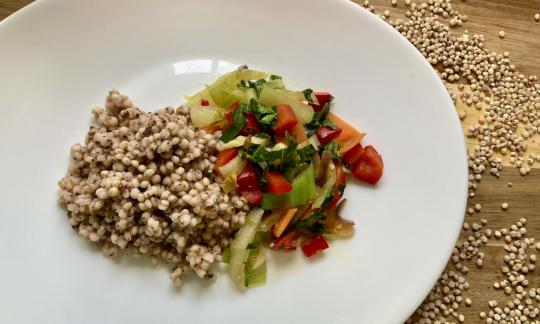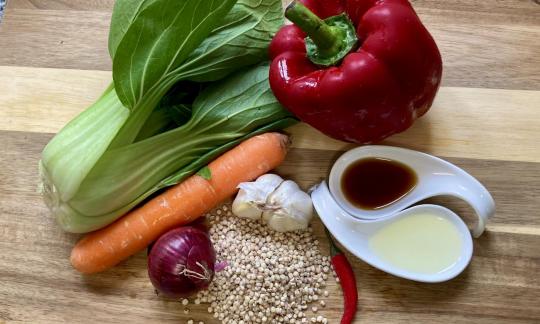sorghum millet with colorful vegetables
vegan
Ingredients (for servings, )
| 5 ½ oz | Sorghum millet (raw, organic?) |
| 300 ml | Drinking water, raw (organic?) (11 oz) |
| 1 | Onions, red (raw, organic?) (2.8 oz) |
| 4 cloves | Garlic (organic?) (0.42 oz) |
| 1 | Chili peppers, red, raw (organic?) (0.18 oz) |
| 2 | Pak choy, raw (bok choy, organic?) (28 oz) |
| 1 | Carrots (carrots), raw (organic?) (2.1 oz) |
| 1 | Sweet peppers, red, raw (organic?) (5.8 oz) |
| 2 tbsp | Rapeseed oil, refined (organic?) (0.98 oz) |
| 1 tbsp | Reduced salt soy sauce (Genen-Shoyu, organic?, raw?) (0.56 oz) |
Equipment
- vegetable peeler
- skillet (frying pan)
- stove
- saucepan
Type of preparation
- cook
- fry
- chop or grind
- sweat
- season to taste
- remove the skin
- peel
- Quellen lassen (ausquellen)
Preparation
For the sorghum millet
Put the sorghum millet in a pot with a lid and add twice the amount of water and bring to the boil. Simmer over a low heat for about 20-25 minutes. Then turn off the stove. If the liquid has not completely boiled away, let the sorghum millet continue to swell until the last of the liquid disappears.Optionally, add some low-salt vegetable stock or a little salt to the sorghum millet in the pot.
Meanwhile, start with the next step.For the vegetables
Peel the onion and garlic. Dice both finely. Finely chop the chili. Wash the pak choi, cut off the stalk and cut the rest into fine rings. Keep the green part separate and cut it a little finer. Peel the carrot and cut it lengthways into thin slices. Then cut the slices into 1-2 cm pieces. Wash the pepper, remove the stalk and seeds and dice.Completing the dish
Pour the rapeseed oil into a non-stick pan. First, sauté the onion for about 2 minutes, then add the remaining vegetables, apart from the pak choi greens, and fry for about 5 minutes. For the last 2 minutes, add the pak choi greens and the soy sauce. Season to taste with soy sauce and chili.
Arrange the finished sorghum millet from step 1 together with the colorful vegetables on plates and serve.
|
Nutritional Information per person
Convert per 100g
|
2000 kcal | |
|---|---|---|
| Energy | 331 kcal | 16.5% |
| Fat/Lipids | 12 g | 16.9% |
| Saturated Fats | 1.1 g | 5.4% |
| Carbohydrates (inc.dietary fiber) | 51 g | 19.0% |
| Sugars | 9.1 g | 10.1% |
| Fiber | 8.3 g | 33.2% |
| Protein/Albumin | 11 g | 22.1% |
| Cooking Salt (Na:365.2 mg) | 928 mg | 38.6% |
| Essential micronutrients with the highest proportions | per person | 2000 kcal | |
|---|---|---|---|
| Vit | Vitamin C (ascorbic acid) | 197 mg | 246.0% |
| Vit | Vitamin K | 184 µg | 245.0% |
| Vit | Vitamin A, as RAE | 877 µg | 110.0% |
| Vit | Vitamin B9, B11 (Folate, as the active form of folic acid) | 221 µg | 110.0% |
| Vit | Vitamin B6 (pyridoxine) | 1.0 mg | 73.0% |
| Min | Manganese, Mn | 1.4 mg | 71.0% |
| Elem | Potassium, K | 1'094 mg | 55.0% |
| Fat | Alpha-Linolenic acid; ALA; 18:3 omega-3 | 1.1 g | 53.0% |
| Prot | Tryptophan (Trp, W) | 0.12 g | 48.0% |
| Sodium, Na | 365 mg | 46.0% | |
Detailed Nutritional Information per Person for this Recipe
The majority of the nutritional information comes from the USDA (US Department of Agriculture). This means that the information for natural products is often incomplete or only given within broader categories, whereas in most cases products made from these have more complete information displayed.
If we take flaxseed, for example, the important essential amino acid ALA (omega-3) is only included in an overarching category whereas for flaxseed oil ALA is listed specifically. In time, we will be able to change this, but it will require a lot of work. An “i” appears behind ingredients that have been adjusted and an explanation appears when you hover over this symbol.
For Erb Muesli, the original calculations resulted in 48 % of the daily requirement of ALA — but with the correction, we see that the muesli actually covers >100 % of the necessary recommendation for the omega-3 fatty acid ALA. Our goal is to eventually be able to compare the nutritional value of our recipes with those that are used in conventional western lifestyles.
| Essential fatty acids | per person | 2000 kcal |
|---|---|---|
| Alpha-Linolenic acid; ALA; 18:3 omega-3 | 1.1 g | 53.0% |
| Linoleic acid; LA; 18:2 omega-6 | 2.6 g | 26.0% |
| Essential amino acids | per person | 2000 kcal |
|---|---|---|
| Tryptophan (Trp, W) | 0.12 g | 48.0% |
| Leucine (Leu, L) | 1.0 g | 43.0% |
| Threonine (Thr, T, irreversibly transaminated) | 0.38 g | 41.0% |
| Isoleucine (Ile, I) | 0.48 g | 39.0% |
| Valin (Val, V) | 0.51 g | 31.0% |
| Phenylalanine (Phe, F) | 0.44 g | 29.0% |
| Lysine (Lys, K, irreversibly transaminated) | 0.42 g | 22.0% |
| Methionine (Met, M) | 0.12 g | 13.0% |
| Vitamins | per person | 2000 kcal |
|---|---|---|
| Vitamin C (ascorbic acid) | 197 mg | 246.0% |
| Vitamin K | 184 µg | 245.0% |
| Vitamin A, as RAE | 877 µg | 110.0% |
| Vitamin B9, B11 (Folate, as the active form of folic acid) | 221 µg | 110.0% |
| Vitamin B6 (pyridoxine) | 1.0 mg | 73.0% |
| Vitamin E, as a-TEs | 4.6 mg | 38.0% |
| Vitamin B1 (Thiamine) | 0.34 mg | 31.0% |
| Vitamin B3 (Niacin) | 4.0 mg | 25.0% |
| Vitamin B2 (Riboflavin) | 0.31 mg | 22.0% |
| Vitamin B5 (Pantothenic acid) | 0.71 mg | 12.0% |
| Vitamin B7 (Biotin, ex vitamin H) | 3.8 µg | 8.0% |
| Essential macroelements (macronutrients) | per person | 2000 kcal |
|---|---|---|
| Potassium, K | 1'094 mg | 55.0% |
| Sodium, Na | 365 mg | 46.0% |
| Phosphorus, P | 279 mg | 40.0% |
| Calcium, Ca | 314 mg | 39.0% |
| Magnesium, Mg | 147 mg | 39.0% |
| Essential trace elements (micronutrients) | per person | 2000 kcal |
|---|---|---|
| Manganese, Mn | 1.4 mg | 71.0% |
| Iron, Fe | 4.3 mg | 30.0% |
| Copper, Cu | 0.25 mg | 25.0% |
| Zinc, Zn | 1.6 mg | 16.0% |
| Selenium, Se | 8.2 µg | 15.0% |
| Fluorine, F | 74 µg | 2.0% |
| Iod, I (Jod, J) | 1.8 µg | 1.0% |
The sorghum millet with colorful vegetables is easy to make and is a nice alternative to rice pan with vegetables.
Nutrient profile: According to GDA guidelines, one portion of this low-calorie dish covers more than twice the average daily requirement of vitamins C and K. Folic acid and vitamin A are also covered at a good 100%. However, some of the heat-sensitive ingredients such as folic acid are lost during the cooking process, which slightly reduces the amount per portion. The ratio of omega-6 to omega-3 fatty acids is 3:1, below the maximum recommended ratio of 5:1.
You can find further information on this topic at the following link: Vegans often eat unhealthily. Avoidable nutritional errors.
Sorghum millet: Sorghum millet, also known as sweet millet, is a staple food in West Africa. As a gluten-free grain, however, it is also becoming increasingly important in Western countries. Sorghum grains are slightly larger than those of common millet. The taste is nutty and slightly sweet, although it can sometimes have a bitter aftertaste.
Pak Choi: Pak Choi, also called Pak Choy or Pok Choi, is a Chinese cabbage. It has a mild taste and hardly needs any time to cook. Before use, depending on the quality and pre-treatment, the outermost leaves and the stalk are removed. The possible uses are similar to those of chard and spinach. The vegetable has a mild, spicy, nutty and slightly mustard-like taste, which is why it is also called Chinese mustard cabbage. In contrast to other types of cabbage, Pak Choi has only a very subtle cabbage taste.
Purchasing sorghum millet: At the time of research (05.2024), most supermarkets and even organic supermarkets in Germany did not yet offer sorghum millet. It is most likely to be found in online shops.
Salad variations: Optionally, you can use chard or Chinese cabbage instead of pak choi for the dish.
Oil-free: If you want to avoid oil altogether, sweat the onion in a little water instead of oil.






